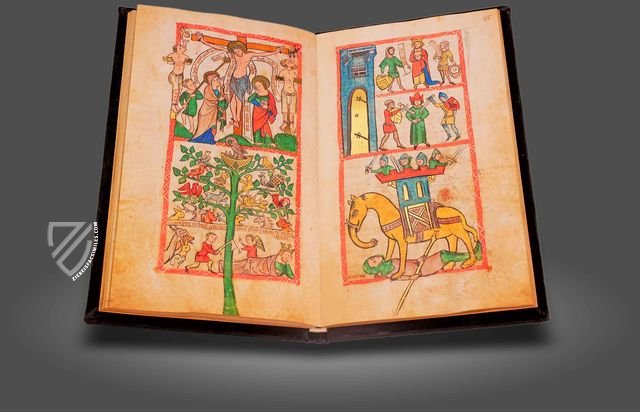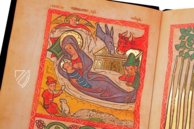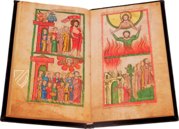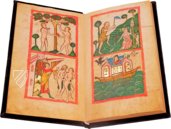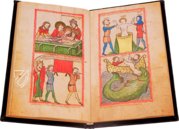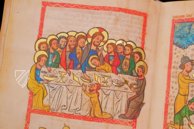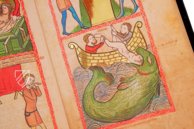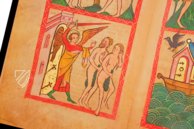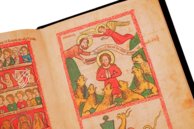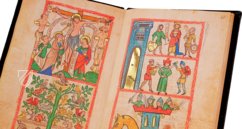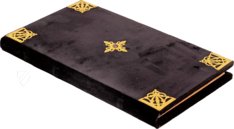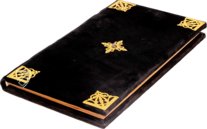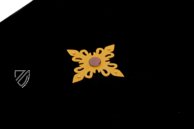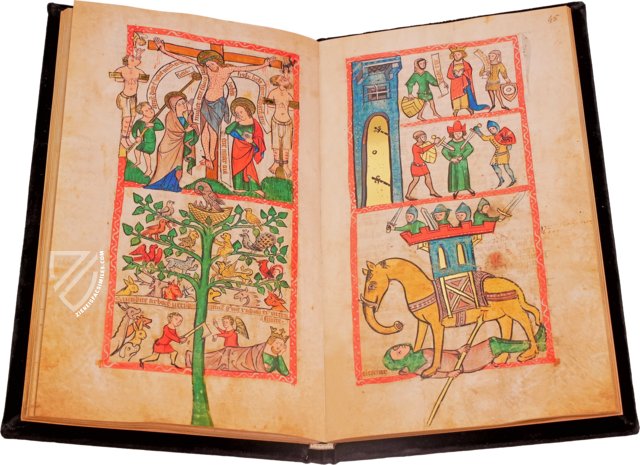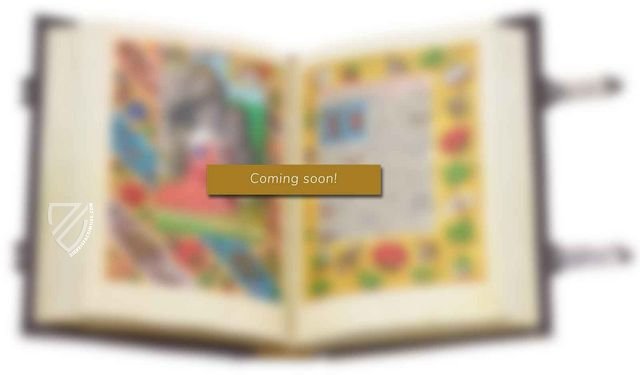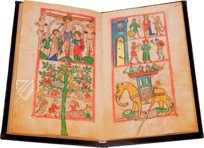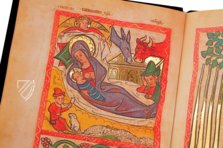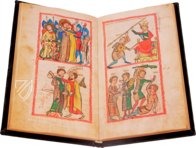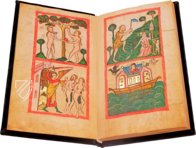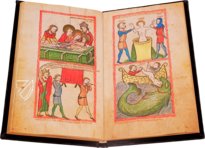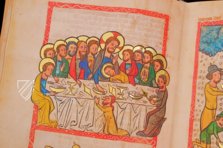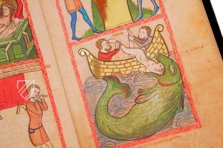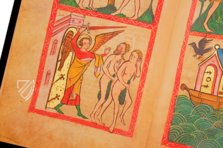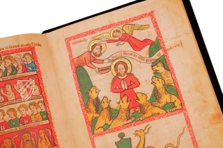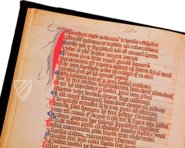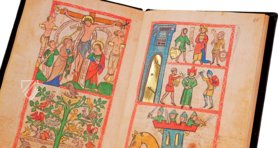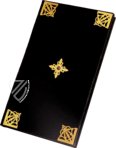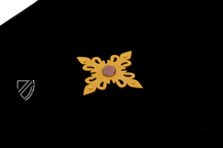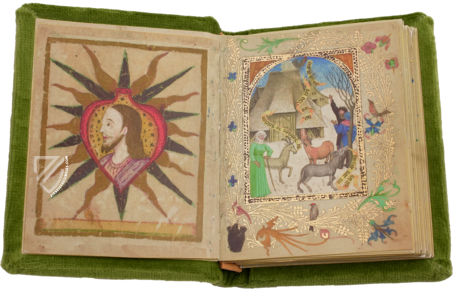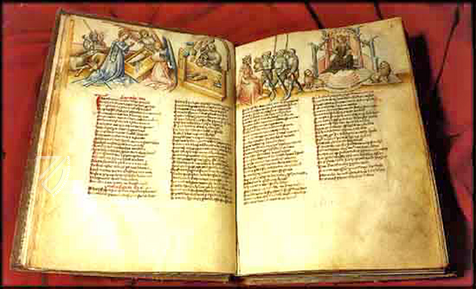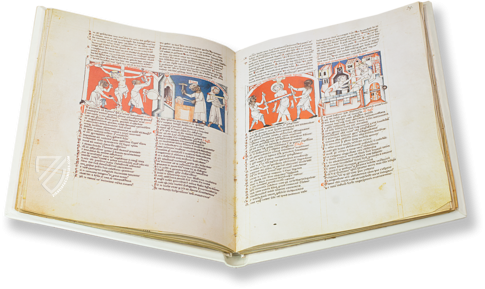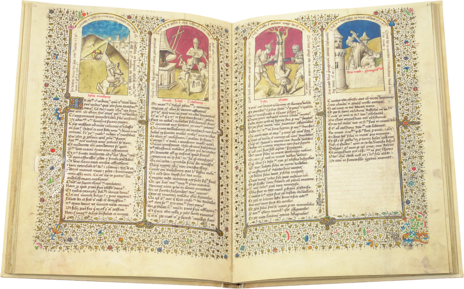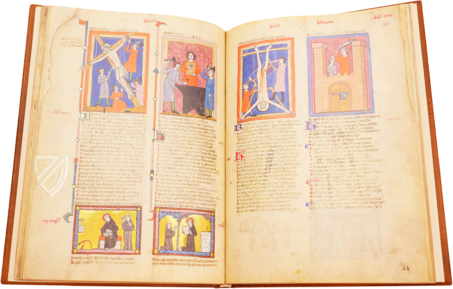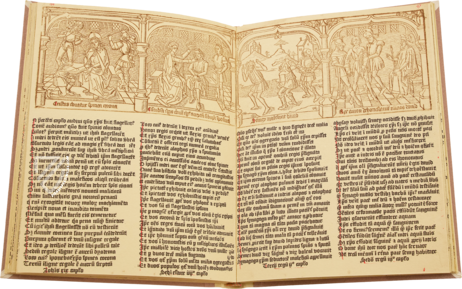Darmstadt Mirror of Human Salvation
(1,000€ - 3,000€)
The Darmstadt Mirror of Salvation is one of the most beautiful and fascinating examples of the Speculum humanae salvationis – a true bestseller of late medieval devotional literature. The rhyming Latin verses and 136 vividly colored miniatures reveal to readers the Christian God's fateful plan of salvation, which, according to the text, is deduced from biblical stories and other historical events that are juxtaposed with one another. In the Darmstadt Mirror of Salvation, the combination of images and text appears in an unusual layout that directs spiritual contemplation particularly to the 68 vividly illustrated pages. From the end of the 14th century, these served to edify the Franciscan nuns at the St. Clara convent at Clarenberg in Hörde, to whom the manuscript was given as a gift by a Dortmund priest from a wealthy merchant family.
Darmstadt Mirror of Human Salvation
The Speculum humanae salvationis (Mirror of Human Salvation) was one of the most widely read works of devotional literature in the late Middle Ages. It served primarily to help lay people understand Christian salvation history and the connections between the Old and New Testaments.
As a typological work, the Mirror of Salvation presented so-called prefigurations: Each New Testament story (‘antitype’) was juxtaposed with three ‘types’ from the Old Testament and, in some cases, from Greek and Roman mythology, whose manifold analogies were intended to prove that the arrival of the Messiah Jesus Christ was predestined and already hinted at in the Jewish writings of the Bible. From this, the all-encompassing plan of salvation by the Christian God was concluded.
Innovative Layout for Deep Contemplation
In the countless manuscripts and prints of this popular work, the text is usually accompanied by miniatures that visually juxtapose the types and antitypes. Typically, text and images are presented together on the pages. In the Darmstadt Mirror of Salvation, the book artists found a different solution: Each pictorial double page is followed by two pages of text, so that text and images can be viewed separately. The miniatures were apparently intended to be viewed first and to stimulate spiritual meditation before the text could be used to delve deeper into the content.
136 Typological Miniatures
The 68 facing pictorial pages are each divided into four sections in red frames and usually show the New Testament ‘type’ in the upper left corner, with three miniatures of Old Testament, ‘antitypical’ scenes below and on the right-hand side. The scenes are often compositionally related to one another. The numerous figures usually appear against a parchment-colored background, which makes the actions seem all the more colorful. Careful inscriptions in narrow scrolls leave no doubt as to who is depicted.
Calligraphic Verses
While the illuminations were probably created by two different hands, only one skilled hand was responsible for the text. This hand wrote the Latin verses in a single column in the most formal and artistic font of the time: the Textura formata. Each double page is also introduced by a large red or blue initial, and each rhyming couplet by a small lombard, also alternating between red and blue.
For the Salvation of Franciscan Nuns
It is still unclear who commissioned this magnificent copy of the Mirror of Salvation. However, it must have been in the possession of the Dortmund priest Thidemann, known as Cleppinck, shortly after its creation around 1360 as he bequeathed it to the Clarenberg Convent of the Poor Clares in Hörde, very close to historic Dortmund, at the end of the 14th century. It was intended for the salvation of the nuns, as indicated by the note of ownership and donation at the end of the manuscript. The convent was converted into a noble ladies' foundation in 1591 and was probably given a new pigskin binding at that time. Sometime before the end of the 18th century, the codex found its way out of the convent and eventually came into the possession of the Baron Hupsch (1730–1805), where it is documented in 1793 and 1803. When the manuscript came to Dortmund, however, remains uncertain. Today it is preserved there under the signature Hs 2505.
Codicology
- Alternative Titles
- Weg zum Seelenheil
Speculum humanae salvationis
Darmstädter Heilsspiegel - Size / Format
- 142 pages / 35.0 × 20.0 cm
- Origin
- Germany
- Date
- Around 1360
- Epochs
- Style
- Genre
- Language
- Script
- Textura formata
- Illustrations
- 68 picture pages with a total of 136 framed miniatures, 3 large pen-flourish initials, and dozens of red and blue lombards
- Content
- A devotional book on Christian salvation history, which interprets the stories of the New Testament with a focus on the lives of Jesus and Mary in a typological manner from the stories of the Old Testament as well as Greek and Roman ancient mythology
- Previous Owners
- Thidemann, known as Cleppinck
Monastery of St. Clara at Clarenberg in Hörde
Johann Wilhelm Carl Adolf von Hüpsch, known as Baron Hupsch (1730–1805)
Darmstadt Mirror of Salvation
Jonah and the Whale
This miniature depicts the Old Testament prophet Jonah being thrown from a ship during a terrible storm on his own instructions, as he is to blame for the life-threatening tempest. His sacrifice for his fellow men is rewarded by God with his rescue by the great green whale. Although it devours him, Jonah survives three days and three nights in its belly until the sea creature spits him out onto land. This story is interpreted in the Mirror of Salvation as a foreshadowing of Christ's resurrection, which only happens after he too has been “three days and three nights in the heart of the earth” (Mt. 12:40).
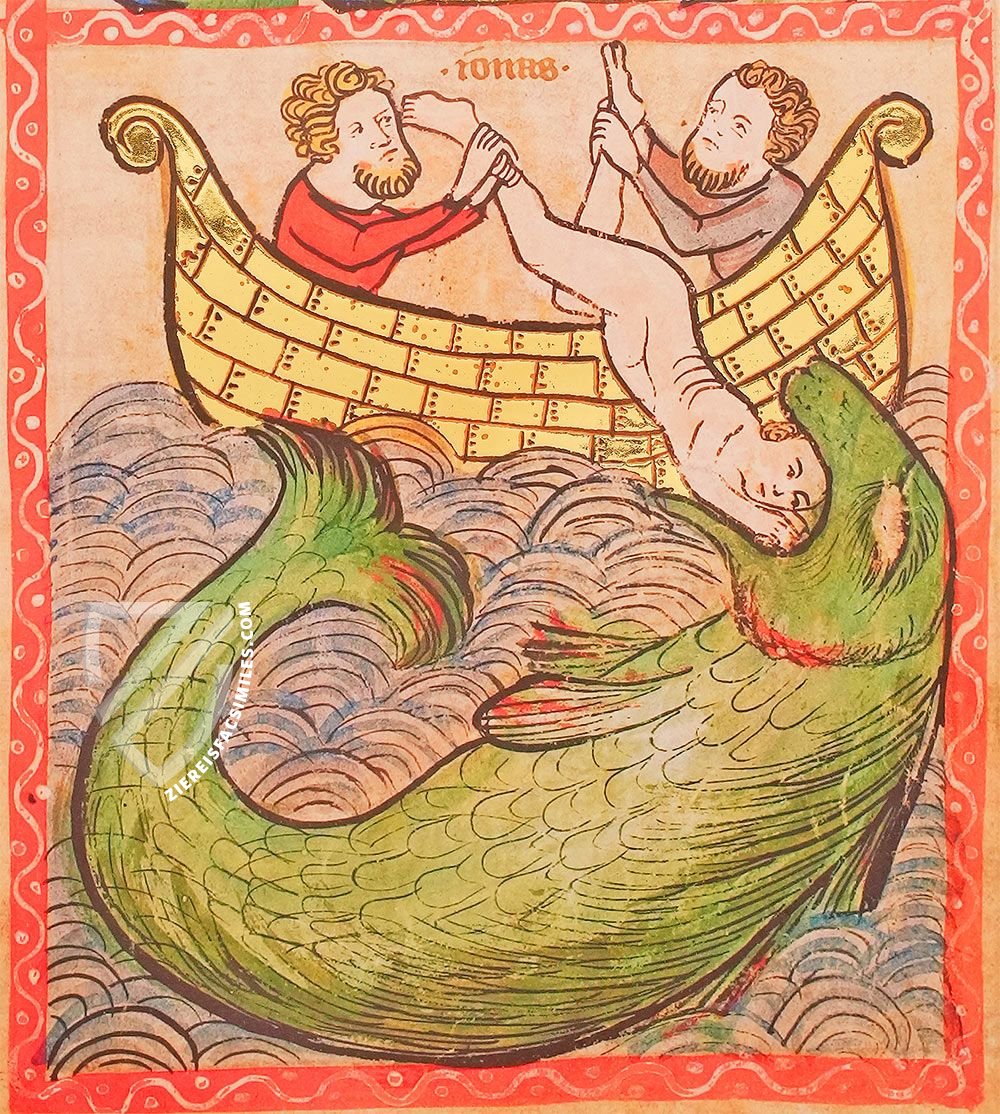
Darmstadt Mirror of Human Salvation
The Dream of the Pharaoh's Cupbearer as a Foretelling of the Nativity
The lower miniature on this page shows the Old Testament cupbearer of the Pharaoh lying under a vine. A so-called stock serves as a shackle, signaling that he is a prisoner. The vine appears to him in a dream. He holds the Pharaoh's cup and squeezes the grape juice into it with his bare hand — a reference to the Eucharist.
Above, Mary is nursing the newborn Jesus, whom she lovingly holds in her arms. In the Mirror of Human Salvation, the cupbearer's dream serves as a type for the birth of the Christian savior, since Jesus is also interpreted in Christian doctrine as a vine that brings about the liberation of humanity through his blood sacrifice.
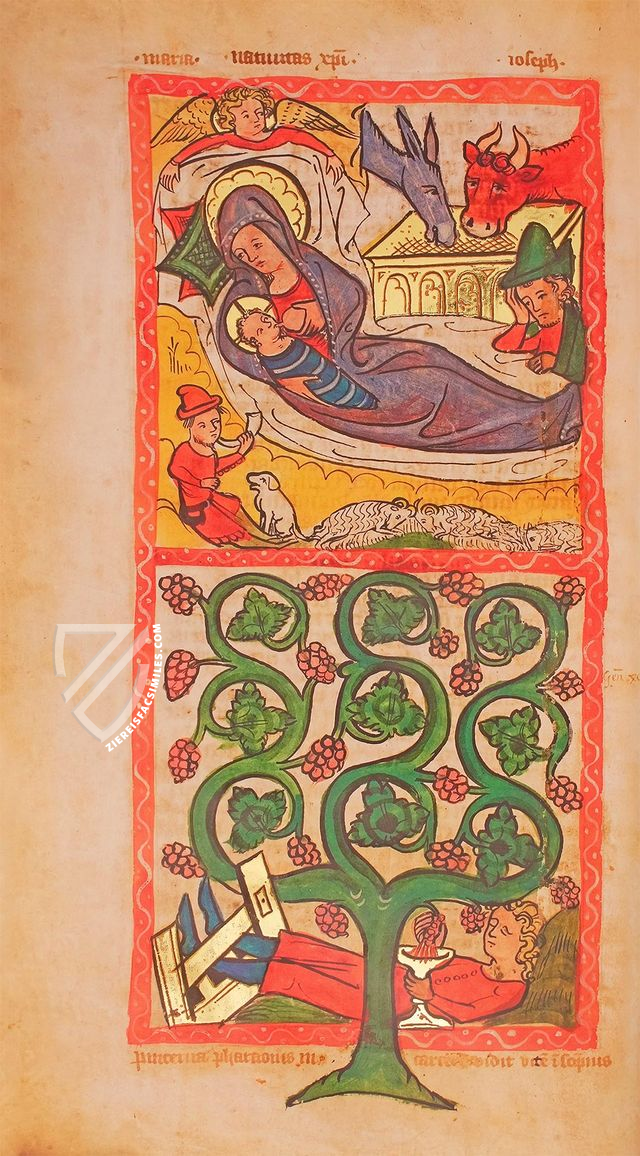
#1 Der Weg zum Seelenheil (Deluxe Edition)
Language: German
(1,000€ - 3,000€)
#2 Speculum Humanis Salvationis (Standard Edition)
Language: Italian
#3 Heilsspiegel. Speculum humanae salvationis.
Language: German
- Treatises / Secular Books
- Apocalypses / Beatus
- Astronomy / Astrology
- Bestiaries
- Bibles / Gospels
- Chronicles / History / Law
- Geography / Maps
- Saints' Lives
- Islam / Oriental
- Judaism / Hebrew
- Single Leaf Collections
- Leonardo da Vinci
- Literature / Poetry
- Liturgical Manuscripts
- Medicine / Botany / Alchemy
- Music
- Mythology / Prophecies
- Psalters
- Other Religious Books
- Games / Hunting
- Private Devotion Books
- Other Genres
- Afghanistan
- Armenia
- Austria
- Belgium
- Belize
- Bosnia and Herzegovina
- China
- Colombia
- Costa Rica
- Croatia
- Cyprus
- Czech Republic
- Denmark
- Egypt
- El Salvador
- Ethiopia
- France
- Germany
- Greece
- Guatemala
- Honduras
- Hungary
- India
- Iran
- Iraq
- Israel
- Italy
- Japan
- Jordan
- Kazakhstan
- Kyrgyzstan
- Lebanon
- Liechtenstein
- Luxembourg
- Mexico
- Morocco
- Netherlands
- Palestine
- Panama
- Peru
- Poland
- Portugal
- Romania
- Russia
- Serbia
- Spain
- Sri Lanka
- Sweden
- Switzerland
- Syria
- Tajikistan
- Turkey
- Turkmenistan
- Ukraine
- United Kingdom
- United States
- Uzbekistan
- Vatican City
- A. Oosthoek, van Holkema & Warendorf
- Aboca Museum
- Ajuntament de Valencia
- Akademie Verlag
- Akademische Druck- u. Verlagsanstalt (ADEVA)
- Aldo Ausilio Editore - Bottega d’Erasmo
- Alecto Historical Editions
- Alkuin Verlag
- Almqvist & Wiksell
- Amilcare Pizzi
- Andreas & Andreas Verlagsbuchhandlung
- Archa 90
- Archiv Verlag
- Archivi Edizioni
- Arnold Verlag
- ARS
- Ars Magna
- ArtCodex
- AyN Ediciones
- Azimuth Editions
- Badenia Verlag
- Bärenreiter-Verlag
- Belser Verlag
- Belser Verlag / WK Wertkontor
- Benziger Verlag
- Bernardinum Wydawnictwo
- BiblioGemma
- Biblioteca Apostolica Vaticana (Vaticanstadt, Vaticanstadt)
- Bibliotheca Palatina Faksimile Verlag
- Bibliotheca Rara
- Boydell & Brewer
- Bramante Edizioni
- Bredius Genootschap
- Brepols Publishers
- British Library
- C. Weckesser
- Caixa Catalunya
- Canesi
- CAPSA, Ars Scriptoria
- Caratzas Brothers, Publishers
- Carus Verlag
- Casamassima Libri
- Centrum Cartographie Verlag GmbH
- Chavane Verlag
- Christian Brandstätter Verlag
- Circulo Cientifico
- Club Bibliófilo Versol
- Club du Livre
- CM Editores
- Collegium Graphicum
- Collezione Apocrifa Da Vinci
- Comissão Nacional para as Comemorações dos Descobrimentos Portugueses
- Coron Verlag
- Corvina
- CTHS
- D. S. Brewer
- Damon
- De Agostini/UTET
- De Nederlandsche Boekhandel
- De Schutter
- Deuschle & Stemmle
- Deutscher Verlag für Kunstwissenschaft
- DIAMM
- Droz
- E. Schreiber Graphische Kunstanstalten
- Ediciones Boreal
- Ediciones Grial
- Ediclube
- Edições Inapa
- Edilan
- Editalia
- Edition Deuschle
- Edition Georg Popp
- Edition Leipzig
- Edition Libri Illustri
- Editiones Reales Sitios S. L.
- Éditions de l'Oiseau Lyre
- Editions Medicina Rara
- Editorial Casariego
- Editorial Mintzoa
- Editrice Antenore
- Editrice Velar
- Edizioni Edison
- Egeria, S.L.
- Eikon Editores
- Electa
- Emery Walker Limited
- Enciclopèdia Catalana
- Eos-Verlag
- Ephesus Publishing
- Ernst Battenberg
- Eugrammia Press
- Extraordinary Editions
- Fackelverlag
- Facsimila Art & Edition
- Facsimile Editions Ltd.
- Facsimilia Art & Edition Ebert KG
- Faksimile Verlag
- Feuermann Verlag
- Folger Shakespeare Library
- Franco Cosimo Panini Editore
- Friedrich Wittig Verlag
- Fundación Hullera Vasco-Leonesa
- G. Braziller
- Gabriele Mazzotta Editore
- Gebr. Mann Verlag
- Gesellschaft für graphische Industrie
- Getty Research Institute
- Giovanni Domenico de Rossi
- Giunti Editore
- Graffiti
- Grafica European Center of Fine Arts
- Guido Pressler
- Guillermo Blazquez
- Gustav Kiepenheuer
- H. N. Abrams
- Harrassowitz
- Harvard University Press
- Helikon
- Hendrickson Publishers
- Henning Oppermann
- Herder Verlag
- Hes & De Graaf Publishers
- Hoepli
- Holbein-Verlag
- Houghton Library
- Hugo Schmidt Verlag
- Idion Verlag
- Il Bulino, edizioni d'arte
- ILte
- Imago
- Insel Verlag
- Insel-Verlag Anton Kippenberger
- Instituto de Estudios Altoaragoneses
- Instituto Nacional de Antropología e Historia
- Introligatornia Budnik Jerzy
- Istituto dell'Enciclopedia Italiana - Treccani
- Istituto Ellenico di Studi Bizantini e Postbizantini
- Istituto Geografico De Agostini
- Istituto Poligrafico e Zecca dello Stato
- Italarte Art Establishments
- Jan Thorbecke Verlag
- Johnson Reprint Corporation
- Josef Stocker
- Josef Stocker-Schmid
- Jugoslavija
- Karl W. Hiersemann
- Kasper Straube
- Kaydeda Ediciones
- Kindler Verlag / Coron Verlag
- Kodansha International Ltd.
- Konrad Kölbl Verlag
- Kurt Wolff Verlag
- La Liberia dello Stato
- La Linea Editrice
- La Meta Editore
- Lambert Schneider
- Landeskreditbank Baden-Württemberg
- Leo S. Olschki
- Les Incunables
- Liber Artis
- Library of Congress
- Libreria Musicale Italiana
- Lichtdruck
- Lito Immagine Editore
- Lumen Artis
- Lund Humphries
- M. Moleiro Editor
- Maison des Sciences de l'homme et de la société de Poitiers
- Manuscriptum
- Martinus Nijhoff
- Maruzen-Yushodo Co. Ltd.
- MASA
- Massada Publishers
- McGraw-Hill
- Metropolitan Museum of Art
- Militos
- Millennium Liber
- Müller & Schindler
- Nahar - Stavit
- Nahar and Steimatzky
- National Library of Wales
- Neri Pozza
- Nova Charta
- Oceanum Verlag
- Odeon
- Orbis Mediaevalis
- Orbis Pictus
- Österreichische Staatsdruckerei
- Oxford University Press
- Pageant Books
- Parzellers Buchverlag
- Patrimonio Ediciones
- Pattloch Verlag
- PIAF
- Pieper Verlag
- Plon-Nourrit et cie
- Poligrafiche Bolis
- Presses Universitaires de Strasbourg
- Prestel Verlag
- Princeton University Press
- Prisma Verlag
- Priuli & Verlucca, editori
- Pro Sport Verlag
- Propyläen Verlag
- Pytheas Books
- Quaternio Verlag Luzern
- Reales Sitios
- Recht-Verlag
- Reichert Verlag
- Reichsdruckerei
- Reprint Verlag
- Riehn & Reusch
- Roberto Vattori Editore
- Rosenkilde and Bagger
- Roxburghe Club
- Salerno Editrice
- Saltellus Press
- Sandoz
- Sarajevo Svjetlost
- Schöck ArtPrint Kft.
- Schulsinger Brothers
- Scolar Press
- Scrinium
- Scripta Maneant
- Scriptorium
- Shazar
- Siloé, arte y bibliofilia
- SISMEL - Edizioni del Galluzzo
- Sociedad Mexicana de Antropología
- Société des Bibliophiles & Iconophiles de Belgique
- Soncin Publishing
- Sorli Ediciones
- Stainer and Bell
- Studer
- Styria Verlag
- Sumptibus Pragopress
- Szegedi Tudomànyegyetem
- Taberna Libraria
- Tarshish Books
- Taschen
- Tempus Libri
- Testimonio Compañía Editorial
- Thames and Hudson
- The Clear Vue Publishing Partnership Limited
- The Facsimile Codex
- The Folio Society
- The Marquess of Normanby
- The Richard III and Yorkist History Trust
- Tip.Le.Co
- TouchArt
- TREC Publishing House
- TRI Publishing Co.
- Trident Editore
- Tuliba Collection
- Typis Regiae Officinae Polygraphicae
- Union Verlag Berlin
- Universidad de Granada
- University of California Press
- University of Chicago Press
- Urs Graf
- Vallecchi
- Van Wijnen
- VCH, Acta Humaniora
- VDI Verlag
- VEB Deutscher Verlag für Musik
- Verlag Anton Pustet / Andreas Verlag
- Verlag Bibliophile Drucke Josef Stocker
- Verlag der Münchner Drucke
- Verlag für Regionalgeschichte
- Verlag Styria
- Vicent Garcia Editores
- W. Turnowski Ltd.
- W. Turnowsky
- Waanders Printers
- Wiener Mechitharisten-Congregation (Wien, Österreich)
- Wissenschaftliche Buchgesellschaft
- Wissenschaftliche Verlagsgesellschaft
- Wydawnictwo Dolnoslaskie
- Xuntanza Editorial
- Zakład Narodowy
- Zollikofer AG

